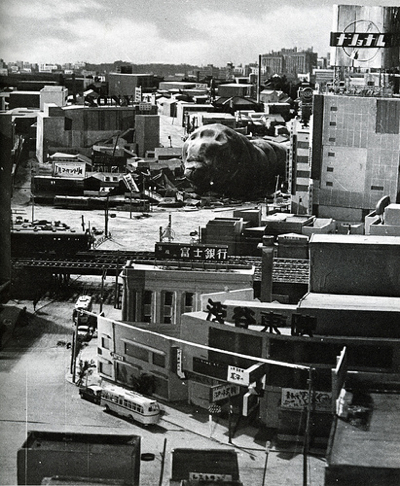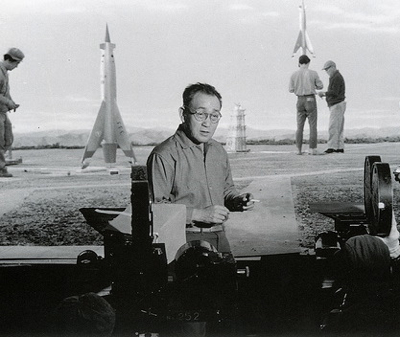
Staggering detail-perfect miniature of the Shibuya Ward in MOTHRA.
MOTHRA
Mosura (Toho, 1961), 101 minutes
Director ISHIRO HONDA • Director of Visual Effects EIJI TSUBURAYA
At the time of its production, MOTHRA was Toho's largest scale kaiju eiga (monster movie) made during the Golden Age, starting with GODZILLA and refined with RODAN. The studio solicited three novelists to each write one-third of a story, based on the treatment for the film, and serialized in the Weekly Asahi. Screenwriter Sekizawa only took basic cues from the short story, added the fairy tale atmosphere, and created a wonderful synergy between the three main characters. The climax in the fictional "New Kirk City" (a hybrid of San Francisco and NYC) was not in the original screenplay, but was commissioned by Columbia Pictures, due to the success of their Stateside releases of THE H-MAN (1958) and BATTLE IN OUTER SPACE (1959). The original ending was already shot and was jettisoned in favor of this new climax, which added far greater scope to the film.
A major element of MOTHRA is the wondrous and beautiful score by seasoned composer Yuji Koseki (1908-1989), who occasionally wrote film music (TOWER OF LILLIES), but whose career concentrated on penning hit songs for Nippon Columbia's pop stars. Koseki was not only chosen because of his previous work with pop sensation The Peanuts (twins Yumi and Emi Ito, who were cast as the "Little Beauties"), but because the film is essentially operatic — the music is an integral part of the story. Koseki had been instrumental in writing The Peanuts' biggest hits, and penned their songs for MOTHRA, "The Song of Mothra" (lyrics by Koji Yuki*) and "The Daughters of Infant Island" (lyrics by Susumu Ike*). Koseki and The Peanuts were the perfect choice for MOTHRA, as its fairly tale setting could have been lost in the heavy compositions of Akira Ifukube.
Tsuburaya's team had their work cut out for them, with the scope and size of the miniature sets needed, as well the sheer number of effects sequences required by the screenplay. The Minato Ward, landmarked by the massive Tokyo Tower, was the most enormous miniature set ever built at the time, and accurate, right down to the last house (in 1/100 scale to accommodate the four foot-long mechanical prop of the caterpillar). Other scenes of the caterpillar wrecking havoc was accomplished with a nearly thirty foot-long "costume," needing seven operators (with veteran monster suit actor Haruo "Godzilla" Nakajima in the lead). The sequence where Mothra thrashes the Shibuya Ward (and it's train station in glorious 1/20-scale) is now fully restored in this presentation. The volume and detail of the visual effects are pure motion picture spectacle — and 43 years after it's first release, is still awe-inspiring in its scope, craftsmanship and sheer audacity.
MOTHRA was a massive hit, selling over sold over nine million tickets (impressive for a country smaller than California). There is much to appreciate about viewing MOTHRA, but it is also the vital lynchpin in the development of the genre. No kaiju eiga, before or since, has touched its size and magnitude — a film like MOTHRA simply could not be produced today. Sekizawa's witty screenplay, spot-on acting from leads Frankie Sakai (SHOGUN), Kyoko Kagawa (HIGH AND LOW), Hiroshi Koizumi (LATE CHRYSANTHEMUMS) and Jerry Ito (YOU CAN SUCCEED, TOO), the wonderful vocals by The Peanuts, inspired direction by Honda and the visual detail of Tsuburaya, make MOTHRA irresistible entertainment — and one of the finest films ever produced by Toho Motion Picture Company.
Executive Producer TOMOYUKI TANAKA Screenplay SHINICHI SEKIZAWA (based on the stories by Shinichiro Nakamura, Takehiko Fukunaga and Yoshie Hotta) Production Design TAKEO KITA and TERUAKI ABE Cinematography HAJIME KOIZUMI Film Editor KAZUJI TAIRA Music YUJI KOSEKI Sound Effects ICHIRO MINAWA Visual Effects Production Design AKIRA WATANABE Optical Photography YUKIO MANODA Visual Effects Photography SADAMASA ARIKAWA
Starring FRANKIE SAKAI (Senichiro Fukuda, Nitto News Reporter) KYOKO KAGAWA (Michi Hanamura, Nitto News Photographer) HIROSHI KOIZUMI (Dr. Shinichi Chujo) KEN UEHARA (Dr. Harada) JERRY ITO (Clark Nelson) YUMI and EMI ITO (Little Beauties) AKIHIRO TAYAMA (Shinji Chujo) SATOSHI NAKAMURA (Nelson's Henchman) OSMAN "JOHNNY" YUSEF (Nelson's Henchman) OBER WYATT (Dr. Roth) ROBERT DUNHAM (New Kirk City Police Chief) ED KEANE (New Kirk City Mayor) and TAKASHI SHIMURA (Amano, Nitto News Editor)
*"Koji Yuki" was the pen name for Tomoyuki Tanaka, Ishiro Honda and Shinichi Sekizawa. "Susumu Ike" was the pen name of Koji Kajita, who was generally Honda's chief assistant director.
MOTHRA plays with BATTLE IN OUTER SPACE at Landmark's Clay Theater in San Francisco on March 20th as part of "Monsters of Mass Destruction: A Tribute to Eiji Tsuburaya" at 3:30 & 7:30 PM









































